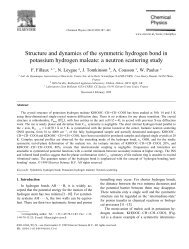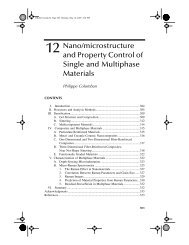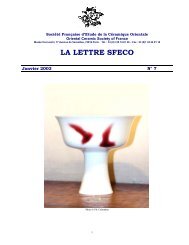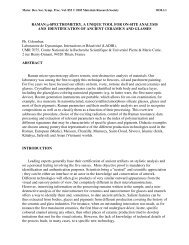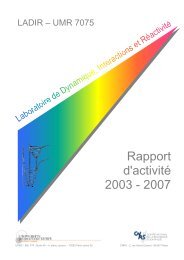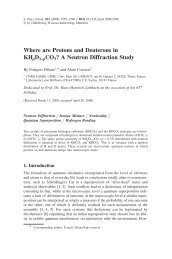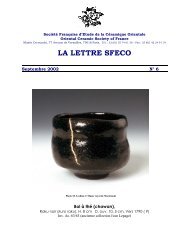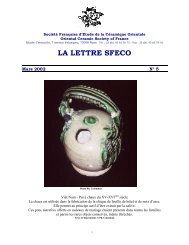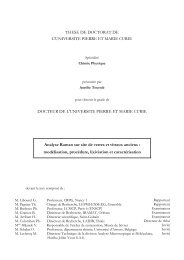Raman Spectroscopy of nanomaterials - institut de chimie et des ...
Raman Spectroscopy of nanomaterials - institut de chimie et des ...
Raman Spectroscopy of nanomaterials - institut de chimie et des ...
Create successful ePaper yourself
Turn your PDF publications into a flip-book with our unique Google optimized e-Paper software.
ARTICLE IN PRESS+ MODELG. Goua<strong>de</strong>c, Ph. Colomban / Progress in Crystal Growth and Characterization <strong>of</strong> Materials 33xx (2007) 1e56mass m and constant stiffness k b . This is the so-called harmonic mo<strong>de</strong>l where the interatomicpotential has the form Vðl b Þ¼ðk b =2Þðl b l 0 Þ 2 :sffiffiffiffin vib ¼ 1 k bð37Þ2pc mk b ¼ v2 Vvl 2 bð38ÞThere is no l b <strong>de</strong>pen<strong>de</strong>nce for the wavenumber in Eq. (37) and the harmonic potential doesnot predict any stress sensitivity for <strong>Raman</strong> bands. Y<strong>et</strong> such mo<strong>de</strong>lling rules out the phenomenon<strong>of</strong> bond dissociation (l b / N) and does not correctly account for atoms non-interpen<strong>et</strong>rability(l b / 0). In fact, the interaction potential should not be limited to a quadratic term and allreal bonds are somewhat anharmonic (Fig. 19). They inclu<strong>de</strong> attractive and repulsive contributions,for which Mie and Grüneisen (Table 1) proposed the following expression, with A, R,a and r being positive constants [419]:Vðl b Þ¼V 0 þ V attractive ðl b ÞþV repulsive ðl b Þ¼V 0A l abþ R l rbIn spite <strong>of</strong> its very significant influence on the physical behaviour <strong>of</strong> materials (only it canexplain thermal expansion or the finite value <strong>of</strong> thermal conductivity [421]), anharmonicity is<strong>of</strong>ten consi<strong>de</strong>red as a simple perturbation: in what is referred to as the ‘‘quasi-harmonic’’ approximation,one consi<strong>de</strong>rs that Eqs. (37) and (38) are applicable to real potentials. Accordingto Fig. 19, atoms are bon<strong>de</strong>d by strings whose stiffness ðv 2 V=vl 2 bÞ increases un<strong>de</strong>r compressionand <strong>de</strong>creases un<strong>de</strong>r tension.In the case <strong>of</strong> the ‘‘quasi-harmonic’’ approximation, Eq. (39) is equivalent to:dn vib¼ dkn 0 2k ¼ 1 aða þ 1Þða þ 2ÞA l ðaþ3Þb rðr þ 1Þðr þ 2ÞR l ðrþ3Þbdl2 rðr þ 1ÞR l ðrþ2Þb aða þ 1ÞA l ðaþ2Þbð40ÞbIntroducing the bond elongation 3 l ¼ (l b l 0 )/l 0 , a Taylor expansion <strong>of</strong> l x b ¼ lx 0 ð1 þ 3 lÞ x (smallstrain assumption) and the requirement for the potential first <strong>de</strong>rivative to be nil at l b ¼ l 0 yield:ð39Þharmonic potential"realistic" potentialEnergyE dissociation0.0 1.0 2.0 3.0I b /I 0Fig. 19. Comparison <strong>of</strong> realistic and harmonic bond potentials.Please cite this article in press as: G. Goua<strong>de</strong>c, Ph. Colomban, Prog. Cryst. Growth Charact. Mater. (2007),doi:10.1016/j.pcrysgrow.2007.01.001



